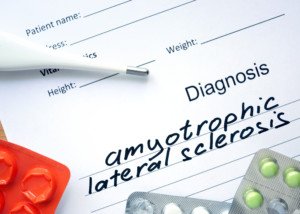
Imagine a doctor walking into the office where you’ve been waiting to hear the results of your muscle twitching worries. He’s not smiling.
Clipboard in hand, he pulls up a stool and licks his lips, eyes lowered a moment.
Then he makes eye contact and says, “I’m so sorry. The test came back positive.
You have ALS – Lou Gehrig’s disease. There is no cure, and life expectancy is usually two to five years after diagnosis.”
How would you feel? Well, this is pretty much the feeling experienced by many healthy people who suffer from benign fasciculation syndrome (which includes muscle twitching).
This harmless condition really messes with the mind, because a lot of people who have an annoying muscle twitch or twitches will invariably do an Internet search, not because they already fear the worst, but because they are merely seeking relief from bothersome twitching.
They expect perhaps to find some dietary or supplement advice, or maybe something about a salve or cream that can be applied to the twitching area.
Instead, their search takes them to ALS sites.
“Muscle twitching” is a symptom of amyotrophic lateral sclerosis, a muscle wasting, fatal disease caused by progressively degenerating nerve cells in the brain and spinal cord.

We all worry at some point or another in our life that we have a killer disease.
Who hasn’t worried they have cancer after noticing a strange birthmark on the back of their leg, or having a persistent cough, stomach cramps, a missed period or strange pain in the knee?
Who hasn’t feared diabetes when they awaken one morning with tingling toes?
Who hasn’t feared a brain tumor from a headache or an imminent heart attack from some chest discomfort?
But some people with benign fasciculation syndrome (BFS) go way overboard.
This is no laughing matter. The anxiety and fear of ALS is overwhelming.
Many sufferers have NOT — I repeat — have NOT had any other hypochondriasis involving other medical conditions before.
The ALS scare is their first. Victims can be any age, including 20s, even though ALS is extremely, extremely rare in this age group (cdc.gov).
So obsessed and profoundly shaken up do BFS sufferers become, that they typically spend inordinate amounts of time conducting strength tests, since muscle weakness is a hallmark ALS symptom.
These home tests can be as follows:
- Continuous standing up and down on one’s toes, on one foot
- Pulling at the feet, toes, fingers or hands to measure resistance strength
- Repeatedly climbing up and down stairs to measure possible weaknes
- Picking up heavy items
- Unscrewing tight jar lids
- Prolonged staring at the twitching area
- Excessive visual examinations comparing the twitching side of the body to the non-twitching side
- Continuous getting in and out of chairs in an attempt to detect leg weakness — and the list goes on.

Shutterstock/Boris Bulychev
The victim thinks of death constantly, worries how family will get along without them, starts imagining life in a wheelchair, life with a trach tube in the throat to breathe for them, what their last breaths will feel like while family members watch, etc.
They visit ALS clinics for exams, and sometimes, one round of negative tests isn’t enough to reassure them that they are healthy.
Many BFS sufferers take antidepressant drugs, because these drugs have been shown to alleviate symptoms of hypochondria, anxiety and obsessive thought processes.
But the drugs do only so much, and drugs aren’t an option for people who want to live naturally without putting drugs in their body.
The anxiety makes BFS symptoms worse, and the symptoms, besides muscle twitching (the biggest twitches are called “thumpers”), can include fatigue, a drained feeling, tingling, cramps (ALS symptom), buzzing, pins and needles sensations, and “perceived weakness.”
Because the sufferer thinks he has ALS, his imagination plays tricks on him and he thinks his muscles have weakened.
This can set off a chain reaction of continuous obsessing over home strength and balance tests in an attempt to reassure himself.

Freepik.com
I began suffering from this malady some years ago, but I recovered quickly and no longer suffer.
It generally takes at least a year, sometimes several years (but sometimes NEVER), for a BFS sufferer to finally feel assured that they are healthy and nothing’s wrong. My cure came after spending some time in cyberspace.
I never had any medical tests. My twitching became markedly subdued after only 12 days from when it started up.
I’ve always had a twitch here and there, but nothing like in those first 10 or 12 days.
If the twitching ever fires up again, I won’t tail spin into an insane fear of a killer disease.
However, many BFS sufferers who go into “remission” will experience a resurge of twitching, sometimes in new areas, many months after the remission, and will revert back to living in constant fear of ALS.













